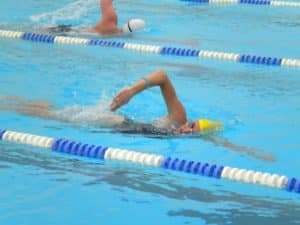How To Work On Pacing

When athletes start swimming for the first time, many feel like they have issues with their breathing. They could be incredibly fit and strong but put them in the water, and they are blowing like a train after one length! The issue here is that at this stage, they only have one pace – things are either on or off, go or stop. Go is 100% effort. If you imagine when you went for your first ever run; the first 2 minutes, you felt amazing, running strong. Next thing you know, you’re gasping for air and needing a pause. This is how you are feeling when you start swimming. As you get experienced with your running, you learn to regulate your effort, and therefore your pace. In the water, you have to learn the same skill. In the same way that you would run a 10k slower than a 5k, or a half marathon slower than a 10k, your swim efforts should reflect the distance that you are aiming to swim.
If you’re a more experienced athlete pacing in your training sessions can help you get the most out of your swims. Swimming is different from biking or running in that it’s easier to go hard every day without tearing up your ligaments and joints. Since you don’t feel the same type of soreness as when you run and bike, swimming leads many triathletes to think that maybe they didn’t swim hard enough. Beware: Swimming hard every day eventually will wear you down and something will give. It could be your shoulder, your back…or your motivation.
So how do you manage your intensity when it feels good to work hard so much of the time
Swim with a plan: Each time you get in the water the workout should have a specific purpose. And every swim set within that workout should have a distinct purpose.

For example:
Drill/Skill Sets: The purpose of a drill session is to practice technique and improve your efficiency. It’s NOT to see how fast you can swim 100 metres while doing fingertip drag or catch up.
Endurance Sets: These sets are designed to create a nice big aerobic engine that will let you swim at race pace for as long as you need to. These sets include 200 metre and up repeats. You may have to swim a set of 3×500 metres. Just like when you swim the speed sets, maintain your pace throughout or get quicker. If you start out at 8:00 for your first 500, and then swim 8:30, and then 9:00 you just blew your whole workout. Remember you want to maintain your pace throughout the reps, and for each rep.
Speed Sets: These sets are designed to teach you how to become efficient at going fast and to raise your top end speed. These sets are NOT designed to see you swim 35 seconds for 50 metres and then swim 45 seconds for the rest. Pick a speed you can handle for the duration of the set. Typically, when I have a set of 10×50 metres, I start out at 30 seconds and aim to maintain that speed. You don’t want to fall apart. Your times shouldn’t vary too much. Learn to swim fast when you are tired – feel what might be falling apart.
The goal of any swim set, be it 50-metre efforts or 800-metre repeats, is to swim with consistency and at an appropriate effort level. The more you start incorporating this into your practices, the faster you will become.
Pacing Skills
There are different ways of swimming sets, that can improve your feel of effort and the pace that you are putting in. Negative splits, build and descending sets will all challenge your ability to change pace and control how you swim.
Negative splits – A common set across various sports; doing the second half of a rep at a faster speed than the first half.
Build – A steady acceleration across the length of a repetition.
Descend – Maintaining a steady speed across each repetition, but swimming each repetition quicker than the last.
The main point is to learn the importance of pacing in the pool. Take it out easy during the first few sets and repeats when you swim. As you warm up, increase your pace. If you find that you’re swimming is getting ragged, or the pace starts to fall away, take a pause at your recovery and workout what needs attention to help you swim stronger and faster.
Practice the way you are going to race and it will become second nature. You want to be the athlete doing the passing at the end of the race, not the one being passed.
Start slow and finish strong.
If you have any questions or comments, please feel free to get in touch; either by email, facebook or leave a comment on here! Remember, you can always get your swimming reviewed in the endless pool with our video swim analysis packages.
See what’s up next week for our #SwimTechTues tip!
